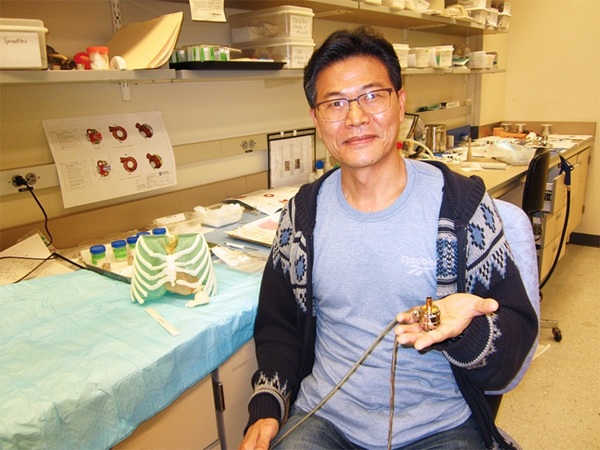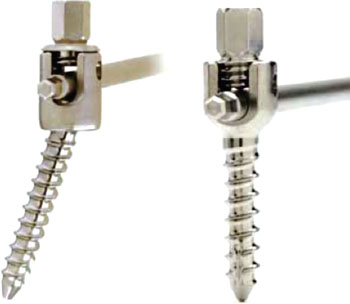Growth Guidance System Straightens Spinal Deformities
|
By HospiMedica International staff writers Posted on 10 Sep 2014 |
A novel growth guidance system treats skeletally immature pediatric patients diagnosed with severe early-onset spinal deformities.
The SHILLA Growth Guidance System is intended for use in pediatric patients with a severe, progressive, life-threatening, scoliosis—defined as a greater than 40° coronal plane Cobb angle or a rib-vertebral angle difference greater than 20°—associated with thoracic and spinal insufficiency that requires surgical treatment before 10 years of age. The system maintains alignment correction and stability during growth, allowing the natural increase of trunk height and unimpeded development of the thoracic cavity. The system is intended to be removed after skeletal maturity.
A unique non-locking set screw at the proximal and distal portions of the construct's rods allow the rod to slide through the screw heads as the child's spine grows, while still providing correction of the deformity. The technology allows correction while maintaining alignment over time, minimizing the need for periodic lengthening procedures and offering effective management of spinal curvature while still harnessing the child's natural growth. The SHILLA Growth Guidance System is a product of Medtronic (Minneapolis, MN, USA), and has been approved by the US Food and Drug Administration (FDA).
“Early onset scoliosis is extremely difficult to treat. The current gold standard technique to manage scoliosis long-term is to fuse the spine, but in children who are still growing this can have serious complications,” said SHILLA inventor orthopedic surgeon Richard McCarthy, MD, of Arkansas Children's Hospital (Little Rock, USA). “Until now we were only able to offer operations which use implants to stabilize the curve in the spine, but these frequently mean twice-yearly surgeries as a child grows.”
Scoliosis is a medical condition in which the spine is curved from side to side. Although a complex three-dimensional deformity, on an X-ray the spine of an individual with scoliosis may look more like an "S" or a "C" than a straight line. Scoliosis is typically classified as congenital, idiopathic, or neuromuscular, when it has developed as a secondary symptom of another condition, such as spina bifida, cerebral palsy, spinal muscular atrophy, or physical trauma.
Related Links:
Medtronic
Arkansas Children's Hospital
The SHILLA Growth Guidance System is intended for use in pediatric patients with a severe, progressive, life-threatening, scoliosis—defined as a greater than 40° coronal plane Cobb angle or a rib-vertebral angle difference greater than 20°—associated with thoracic and spinal insufficiency that requires surgical treatment before 10 years of age. The system maintains alignment correction and stability during growth, allowing the natural increase of trunk height and unimpeded development of the thoracic cavity. The system is intended to be removed after skeletal maturity.
A unique non-locking set screw at the proximal and distal portions of the construct's rods allow the rod to slide through the screw heads as the child's spine grows, while still providing correction of the deformity. The technology allows correction while maintaining alignment over time, minimizing the need for periodic lengthening procedures and offering effective management of spinal curvature while still harnessing the child's natural growth. The SHILLA Growth Guidance System is a product of Medtronic (Minneapolis, MN, USA), and has been approved by the US Food and Drug Administration (FDA).
“Early onset scoliosis is extremely difficult to treat. The current gold standard technique to manage scoliosis long-term is to fuse the spine, but in children who are still growing this can have serious complications,” said SHILLA inventor orthopedic surgeon Richard McCarthy, MD, of Arkansas Children's Hospital (Little Rock, USA). “Until now we were only able to offer operations which use implants to stabilize the curve in the spine, but these frequently mean twice-yearly surgeries as a child grows.”
Scoliosis is a medical condition in which the spine is curved from side to side. Although a complex three-dimensional deformity, on an X-ray the spine of an individual with scoliosis may look more like an "S" or a "C" than a straight line. Scoliosis is typically classified as congenital, idiopathic, or neuromuscular, when it has developed as a secondary symptom of another condition, such as spina bifida, cerebral palsy, spinal muscular atrophy, or physical trauma.
Related Links:
Medtronic
Arkansas Children's Hospital
Read the full article by registering today, it's FREE! 

Register now for FREE to HospiMedica.com and get access to news and events that shape the world of Hospital Medicine. 
- Free digital version edition of HospiMedica International sent by email on regular basis
- Free print version of HospiMedica International magazine (available only outside USA and Canada).
- Free and unlimited access to back issues of HospiMedica International in digital format
- Free HospiMedica International Newsletter sent every week containing the latest news
- Free breaking news sent via email
- Free access to Events Calendar
- Free access to LinkXpress new product services
- REGISTRATION IS FREE AND EASY!
Sign in: Registered website members
Sign in: Registered magazine subscribers
Latest Surgical Techniques News
- Minimally Invasive Surgery Proven Safe and Effective for Complex ‘Whipple’ Procedure
- Catheter-Based Procedures Offer Less Invasive Option for Treatment of Valvular Disease
- Laparoscopic Surgery Improves Outcomes for Severe Newborn Liver Disease
- Novel Endoscopy Technique Provides Access to Deep Lung Tumors
- New Study Findings Could Halve Number of Stent Procedures
- Breakthrough Surgical Device Redefines Hip Arthroscopy
- Automated System Enables Real-Time "Molecular Pathology" During Cancer Surgery
- Groundbreaking Procedure Combines New Treatments for Liver Tumors
- Ablation Reduces Stroke Risk Associated with Atrial Fibrillation
- Optical Tracking Method Identifies Target Areas in Robot-Assisted Neurosurgery
- General Anesthesia Improves Post-Surgery Outcomes for Acute Stroke Patients
- Drug-Coated Balloons Can Replace Stents Even in Larger Coronary Arteries
- Magnetic Kidney Stone Retrieval Device Outperforms Ureteroscopic Laser Lithotripsy
- Absorbable Skull Device Could Replace Traditional Metal Implants Used After Brain Surgery
- Magic Silicone Liquid Powered Robots Perform MIS in Narrow Cavities
- 'Lab-on-a-Scalpel' Provides Real-Time Surgical Insights for POC Diagnostics in OR
Channels
Critical Care
view channel
Breathable Electronic Skin Paves Way for Next-Generation Wearable Devices
Electronic skin devices are designed to adhere closely to the human body to monitor health and biosignals, but long-term use often leads to skin irritation caused by trapped sweat and poor breathability.... Read more
AI Transforming Colon Cancer Diagnosis
Colon cancer remains one of the most common and deadly cancers worldwide, with diagnosis often relying on time-consuming procedures such as colonoscopy and histopathological analysis. Delays or inaccuracies... Read more
Ventricular Assist Device Offers Long-Term Use in Children Waiting for Donor Heart
Children with severe heart failure often face long and dangerous waits for a donor heart, with limited options to keep them stable during this period. For patients between the ages of one and 11, there... Read more
Precision Approach Improves Immunotherapy Effectiveness for ICU Patients with Sepsis
Sepsis occurs when the immune system responds abnormally to an infection, often triggering life-threatening organ failure. Despite affecting around 49 million people globally each year and causing approximately... Read morePatient Care
view channel
Revolutionary Automatic IV-Line Flushing Device to Enhance Infusion Care
More than 80% of in-hospital patients receive intravenous (IV) therapy. Every dose of IV medicine delivered in a small volume (<250 mL) infusion bag should be followed by subsequent flushing to ensure... Read more
VR Training Tool Combats Contamination of Portable Medical Equipment
Healthcare-associated infections (HAIs) impact one in every 31 patients, cause nearly 100,000 deaths each year, and cost USD 28.4 billion in direct medical expenses. Notably, up to 75% of these infections... Read more
Portable Biosensor Platform to Reduce Hospital-Acquired Infections
Approximately 4 million patients in the European Union acquire healthcare-associated infections (HAIs) or nosocomial infections each year, with around 37,000 deaths directly resulting from these infections,... Read moreFirst-Of-Its-Kind Portable Germicidal Light Technology Disinfects High-Touch Clinical Surfaces in Seconds
Reducing healthcare-acquired infections (HAIs) remains a pressing issue within global healthcare systems. In the United States alone, 1.7 million patients contract HAIs annually, leading to approximately... Read moreHealth IT
view channel
EMR-Based Tool Predicts Graft Failure After Kidney Transplant
Kidney transplantation offers patients with end-stage kidney disease longer survival and better quality of life than dialysis, yet graft failure remains a major challenge. Although a successful transplant... Read more
Printable Molecule-Selective Nanoparticles Enable Mass Production of Wearable Biosensors
The future of medicine is likely to focus on the personalization of healthcare—understanding exactly what an individual requires and delivering the appropriate combination of nutrients, metabolites, and... Read moreBusiness
view channel
Philips and Masimo Partner to Advance Patient Monitoring Measurement Technologies
Royal Philips (Amsterdam, Netherlands) and Masimo (Irvine, California, USA) have renewed their multi-year strategic collaboration, combining Philips’ expertise in patient monitoring with Masimo’s noninvasive... Read more
B. Braun Acquires Digital Microsurgery Company True Digital Surgery
The high-end microsurgery market in neurosurgery, spine, and ENT is undergoing a significant transformation. Traditional analog microscopes are giving way to digital exoscopes, which provide improved visualization,... Read more
CMEF 2025 to Promote Holistic and High-Quality Development of Medical and Health Industry
The 92nd China International Medical Equipment Fair (CMEF 2025) Autumn Exhibition is scheduled to be held from September 26 to 29 at the China Import and Export Fair Complex (Canton Fair Complex) in Guangzhou.... Read more









.jpg)





